The Versatility of Bamboo: An In-Depth Look at Its Ecological Importance and Human Uses

(wikipedia.org)
(Ecological Importance)
Habitat and Biodiversity
Bamboo forests are vital ecological zones that support a diverse array of wildlife. In the dense bamboo thickets of Asia, these forests provide essential habitat and food sources for numerous species. The giant panda, one of the most well-known bamboo-dependent animals, relies on bamboo as nearly its exclusive food source. This diet supports not only the panda’s nutritional needs but also its role as a key species in the ecosystem. Beyond pandas, bamboo forests are home to various insects, such as the bamboo beetle, numerous bird species like the red-billed leiothrix, and small mammals such as the bamboo rat. These animals utilize bamboo forests for shelter, nesting, and protection from predators. The dense, multi-layered structure of bamboo stands offers cover from harsh weather and predators, creating a unique microhabitat that supports complex ecological interactions.
Soil Conservation
Bamboo’s root system is integral to soil conservation and land stability. The extensive network of fibrous roots penetrates deeply into the soil, binding it together and reducing erosion. This is particularly important in regions prone to landslides and erosion, where bamboo can act as a natural barrier to soil displacement. By stabilizing the soil, bamboo helps maintain the landscape and prevents the loss of fertile topsoil. Additionally, the presence of bamboo in riparian zones (areas along rivers and streams) helps mitigate the impact of flooding and runoff by absorbing excess water and stabilizing riverbanks. The improved soil structure and fertility resulting from bamboo’s root system also support the growth of other plant species, enhancing overall biodiversity in the area.
Carbon Sequestration
Bamboo is a potent tool in the fight against climate change due to its remarkable carbon sequestration capabilities. Its rapid growth rate—often exceeding one meter per day in optimal conditions—enables bamboo to absorb significant amounts of carbon dioxide from the atmosphere. As bamboo grows, it captures carbon through photosynthesis and stores it in its biomass. This process contributes to reducing the concentration of greenhouse gases in the atmosphere. Studies have shown that bamboo forests can sequester more carbon per unit area compared to many traditional forests, making them highly effective in combating global warming. Additionally, bamboo’s ability to regrow quickly after harvesting, without the need for replanting, ensures that its carbon sequestration benefits are sustained over time. The incorporation of bamboo into climate action strategies, such as reforestation and afforestation projects, highlights its potential as a key element in global efforts to mitigate climate change.
By understanding the ecological significance of bamboo, we can better appreciate its role in maintaining biodiversity, protecting soil, and addressing climate change. Its multifaceted contributions underscore the importance of conserving bamboo forests and integrating bamboo into sustainable practices.
(Human Uses)
Construction and Furniture
Bamboo’s remarkable strength, flexibility, and rapid growth rate make it an exceptional material for a variety of construction applications. In many Asian countries, bamboo has long been utilized in the building of houses, bridges, and scaffolding. Its lightweight nature reduces transportation costs and makes it easier to handle, while its durability ensures structural integrity. In modern architecture, bamboo is increasingly being incorporated into innovative designs for residential and commercial buildings, showcasing its potential as a sustainable alternative to traditional construction materials such as timber and steel.
In addition to structural uses, bamboo is highly valued for its applications in furniture design. Bamboo furniture is not only aesthetically pleasing but also durable and versatile. Its natural texture and flexibility allow for creative and functional designs, from sleek contemporary pieces to traditional styles. The sustainability of bamboo furniture is an added benefit, as it comes from a rapidly renewable resource, reducing the environmental impact associated with deforestation and resource depletion.
Crafts and Art
The versatility of bamboo extends deeply into the world of crafts and art. Skilled artisans around the globe utilize bamboo to create a wide array of intricate designs and functional items. Traditional crafts include woven baskets, mats, and furniture, where bamboo’s pliability and strength are utilized to produce durable and beautiful products. In many cultures, bamboo is also used to make musical instruments such as flutes, drums, and xylophones, where its resonance and tonal qualities are highly prized.
Contemporary artists and designers are exploring new uses for bamboo, pushing the boundaries of its application in modern decorative arts. Bamboo’s ease of manipulation allows for innovative sculptural works and decorative pieces that blend traditional craftsmanship with modern aesthetics. Its availability and low cost make it a preferred material for both amateur and professional artists seeking to create unique and eco-friendly art forms.
Food and Medicine
Bamboo shoots are a staple ingredient in many Asian cuisines, prized for their crisp texture and mild flavor. Rich in essential vitamins, minerals, and antioxidants, bamboo shoots are a nutritious addition to various dishes, from stir-fries to soups. Their low calorie content and high fiber make them a healthy choice for those seeking to maintain a balanced diet.
Beyond its culinary uses, bamboo has a long history of medicinal applications. Various parts of the bamboo plant, including leaves, stems, and shoots, are used in traditional medicine practices to treat a range of ailments. Bamboo leaves are often employed in herbal remedies for their purported benefits in treating respiratory conditions and digestive issues. Bamboo ash has been used in some cultures as a topical treatment for skin problems. The integration of bamboo into modern herbal medicine reflects its continued relevance and potential in holistic health practices.
Sustainable Products
Bamboo’s rapid growth and regenerative capabilities make it a crucial player in the development of sustainable products. As concerns over environmental impact and plastic waste increase, bamboo offers a viable alternative for eco-friendly consumer goods. Biodegradable bamboo utensils, straws, and toothbrushes are becoming popular choices for environmentally conscious consumers looking to reduce their reliance on single-use plastics. Bamboo-based products help decrease plastic pollution by providing sustainable and compostable options.
In the fashion industry, bamboo fibers are being used to create eco-friendly fabrics that are soft, breathable, and biodegradable. Bamboo textiles are gaining recognition for their sustainability, as bamboo can be grown with minimal use of pesticides and fertilizers, and its fibers require less water and energy compared to conventional cotton production. The use of bamboo in sustainable fashion highlights its potential to contribute to a more environmentally friendly and circular economy.
By exploring and utilizing bamboo’s diverse applications, we can enhance our understanding of this remarkable plant and leverage its benefits for both ecological and practical purposes. Whether in construction, crafts, food, or sustainable products, bamboo stands out as a symbol of innovation and environmental stewardship.
(Challenges and Considerations)
Invasive Potential
Despite its numerous benefits, bamboo poses certain ecological risks, particularly when it comes to its invasive potential. Some species of bamboo, especially the running types, can spread aggressively due to their vigorous root systems. This rapid spread can lead to bamboo outcompeting native plant species, thereby disrupting local ecosystems and reducing biodiversity. The dense bamboo thickets may choke out other vegetation, alter soil composition, and impact wildlife that depends on a diverse plant community.
To mitigate these issues, it is crucial to implement effective management practices for bamboo cultivation. This includes selecting appropriate bamboo species for planting, employing physical barriers to control spread, and conducting regular monitoring to assess and address any unintended ecological impacts. In areas where bamboo is used for reforestation or agroforestry, careful planning and management are essential to ensure that its introduction does not negatively impact native flora and fauna.
Economic and Social Impact
The cultivation and utilization of bamboo can have profound economic and social impacts, especially in rural communities where bamboo farming and crafting are integral to livelihoods. Bamboo provides a source of income for many through activities such as farming, harvesting, and producing bamboo-based products like furniture, crafts, and building materials. In regions where bamboo is a traditional resource, it supports local economies and contributes to community well-being.
However, the development of bamboo industries must be approached with consideration for fair labor practices and equitable distribution of benefits. Rapid commercialization and large-scale bamboo projects can sometimes lead to issues such as exploitation of labor, land rights conflicts, and unequal sharing of economic benefits. Ensuring that local communities are involved in decision-making processes and that they receive fair compensation for their work is essential for the sustainable and ethical development of bamboo industries. Additionally, supporting local craftsmanship and small-scale enterprises can help maintain traditional knowledge and practices while promoting economic resilience.
While bamboo offers numerous advantages, it is important to address the challenges associated with its cultivation and use. By implementing effective management practices to control its invasive potential and ensuring fair economic and social practices, we can maximize the benefits of bamboo while minimizing potential drawbacks. Thoughtful and responsible approaches to bamboo cultivation and utilization will help preserve its ecological benefits, support sustainable development, and improve the livelihoods of those who rely on this remarkable plant.
Conclusion,
Bamboo stands out as an extraordinary plant with a profound impact on both natural ecosystems and human societies. Its ecological importance is underscored by its role in providing vital habitats for wildlife, preventing soil erosion, and sequestering carbon, which makes it a key player in mitigating climate change. The dense bamboo forests support diverse species and contribute to the health and stability of various environments.
On the human side, bamboo’s versatility is equally impressive. Its applications range from construction and furniture to crafts, food, and sustainable products. This remarkable plant offers a sustainable alternative to traditional materials, helping reduce environmental impact and support sustainable development. Bamboo’s rapid growth and regenerative properties make it an invaluable resource for creating eco-friendly products and practices.
However, the cultivation and use of bamboo are not without challenges. Its invasive potential necessitates careful management to prevent ecological disruption, and the economic benefits must be balanced with fair labor practices to ensure equitable outcomes for all involved.
By appreciating and harnessing bamboo’s diverse attributes, we can better integrate this plant into our efforts to promote environmental sustainability and innovation. Embracing bamboo not only supports ecological conservation but also drives advancements in sustainable living and industry. As we continue to explore and utilize bamboo’s potential, it is crucial to approach its cultivation and application with thoughtful consideration to maximize its benefits while minimizing potential drawbacks.



